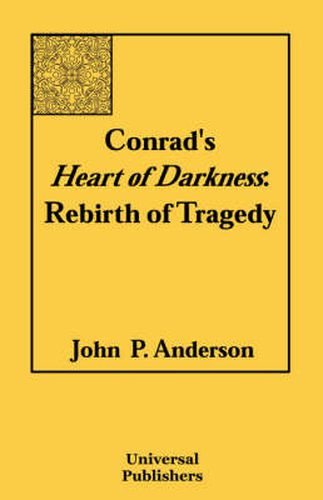Conrad's Heart of Darkness: Rebirth of Tragedy
John P Anderson

Conrad’s Heart of Darkness: Rebirth of Tragedy
John P Anderson
This title is printed to order. This book may have been self-published. If so, we cannot guarantee the quality of the content. In the main most books will have gone through the editing process however some may not. We therefore suggest that you be aware of this before ordering this book. If in doubt check either the author or publisher’s details as we are unable to accept any returns unless they are faulty. Please contact us if you have any questions.
This is a reader’s guide to Conrad’s novel Heart of Darkness as art, not as a page-turner but as art. As he has done with other works of Conrad, Anderson traces Conrad’s art in a line-by-line analysis of most of this short novel. Anderson traces the unifying theme of the novel to Nietzsche’s ideas in The Birth of Tragedy. Nietzsche interpreted ancient Greek tragedy as a reflection of Dionysian and Apollinian life experiencesof the Greek audience. Apollo was a Greek god of the higher orders of civilization and the civilized restraint and control that is necessary for getting along with others. Dionysus, on the other hand, was agod of nature and fertility and is associated with unrestrained, orgiastic worship. This author shows how Conrad used the contrast between the Apollinian and Dionysian to structure the form and content of the novel: how the contrast holds together the important artistic decisions made by Conrad; how Conrad midwived the rebirth of ancient Greek tragedy as the Congo tragedy-the rape of the Congo by Europeans in the late 19th century; and how this could have happened-how the psyches of the Europeans unraveled in the Congo jungle. In Conrad’s rendition, the unrestrained competitive and hostile Dionysian life forces at the heart of nature not only power the teeming jungle but also lurk in the inherited instincts of mankind. The European search for ivory in the Congo brought these primitive instincts to the surface, out of their holes like serpents with venom of a mixture of desire and hate. The high ground of the novel is an irony-in the Congo clothes do not make the man. The European exploiters dressed in the very proper tropical whites are savage in behavior while naked man-eaters are restrained in behavior. As with Nietzsche before him, Conrad’s approach anticipated central doctrines of Freud and Jung. Conrad’s use of Nietzschean elements gives many modern readers a sense of dread or uneasiness, suggesting that the Nietzschean elements jostle important structures in our unconscious.
This item is not currently in-stock. It can be ordered online and is expected to ship in 7-14 days
Our stock data is updated periodically, and availability may change throughout the day for in-demand items. Please call the relevant shop for the most current stock information. Prices are subject to change without notice.
Sign in or become a Readings Member to add this title to a wishlist.

